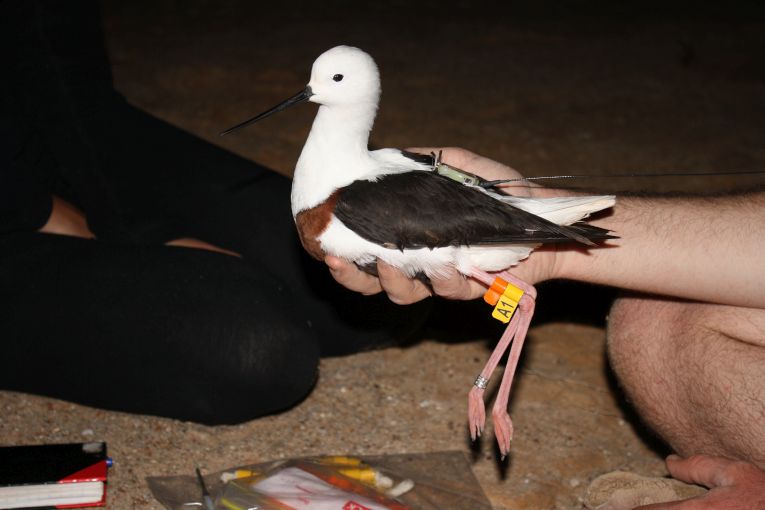The Biology Letters of the Royal Society this week feature the nomads of the Australian desert, the banded stilt, Cladorhynchus leucocephalus.To find water in the redness of the interior, these migrants have no fixed pattern of movement, instead they have always seemed able to find water where we couldn’t. The rains in desert situations are short lived, but rapidly produce growth from the flowering plants, and breeding in the tiny animals these birds feed on. Few relatives exist for this wader, but the other 4 stilt species and the avocets are well-known because of their worldwide distribution.
Remote inland salt lakes are the breeding locations for the birds, 21 were tracked at these distant water bodies. 2 birds left from the coast after rain and then 12 migrated to the coast from drying sites inland. The distances involved were up to 2000km, and a mean of 684km (up to 1298km), in these 2 examples. Only 3 of the birds were female, although one sex was undetermined.
The trapping of these breeding birds was performed carefully with walk-in traps while the non-breeders were caught while foraging with a net gun. With no seasonality to the rains, this species relies on its innate ability to find water. The dangers are obvious: 2 birds were quickly lost to predators within 150km of their catch site. Silver gulls, Chroicocephalus novaehollandiae are a very common predator and are often culled for that reason. The rest travelled throughout the continent, either between inland lakes, or to and from the coast. These journeys were made more rapidly and for longer distances than those of other birds. The interest probably lies in the tiny mass (300g) of the stilt compared to its cohabitors such as the lesser flamingo (2000g) or the grey teal (600g.)
How does this bird achieve the detection of water sources? No ranging (ie. exploratory) movements were employed, unlike the other species. Flights were very direct. Low frequency sound, temperature change, or air pressure gradients can indicate possibility of rainfall, but these fights often took place many weeks after rain. Smell (olfaction) is the more likely sensor involved. SE Australia and Western Australia were linked several times with individuals in flocks reaching the same watery destination form totally separate origins. Incidentally, this is the first time these flocks have been linked geographically, proving they are not separate populations. It would take a lot to stop these tiny tearaways.
It is really strange that only this bird species has a coherent migration strategy, whereas other species simply discover water individually, probably by pure luck! The authors are brave to explore new sensory possibilities in the banded stilt. R. D. Pedler, R. F. H. Ribot and A. T. D. Bennett provide us with the paper in- Extreme nomadism in desert water birds: flights of the banded stilt. They work at Deakin University’s Centre for Integrative Ecology in Victoria, We were interested that Deakin University featured once again after this masterful account of woodland bird distribution such as that of the rare swift parrot here in - Riparian sites are better for bird variety.










